Back to Basics
Intro to Deep Learning : MLPs
TensorFlow & Deep Learning SG
Part 1 of 3
Deep Learning
MeetUp Group
- Next "Real" Meet-Up ~ one month
-
- Likely to be research-orientated
- Typical Contents :
-
- Talk for people starting out
- Something from the bleeding-edge
- Lightning Talks
- MeetUp.com / TensorFlow-and-Deep-Learning-Singapore
- Running since 2017 : Over 4500 members!
"Back to Basics"
- This is a three-part introductory series :
-
- Appropriate for Beginners!
- Code-along is helpful for everyone!
- This week : MLPs (fundamentals)
- Next week : CNNs (for vision)
- Third week : Transformers (for text)
Plan of Action
- Each part has 2 segments :
-
- Talk = Mostly Martin
- Code-along = Mostly Sam
- Ask questions at any time!
Today's Talk
- (Housekeeping)
- Short intro to "AI"
- Programming vs Machine Learning vs Deep Learning
- Simple example with handwaving
- Concrete example(s) with code
-
- Fire up your browser for code-along
About Me
- Machine Intelligence / Startups / Finance
-
- Moved from NYC to Singapore in Sep-2013
- 2014 = 'fun' :
-
- Machine Learning, Deep Learning, NLP
- Robots, drones
- Since 2015 = 'serious' :: NLP + deep learning
-
- GDE ML; TF&DL co-organiser
- Red Dragon AI...
About Red Dragon AI
- Google Partner : Deep Learning Consulting & Prototyping
- SGInnovate/Govt : Education / Training
- Research : NeurIPS / EMNLP / NAACL
- Products :
-
- Conversational Computing
- Natural Voice Generation - multiple languages
- Knowledgebase interaction & reasoning
Deep Learning Applications
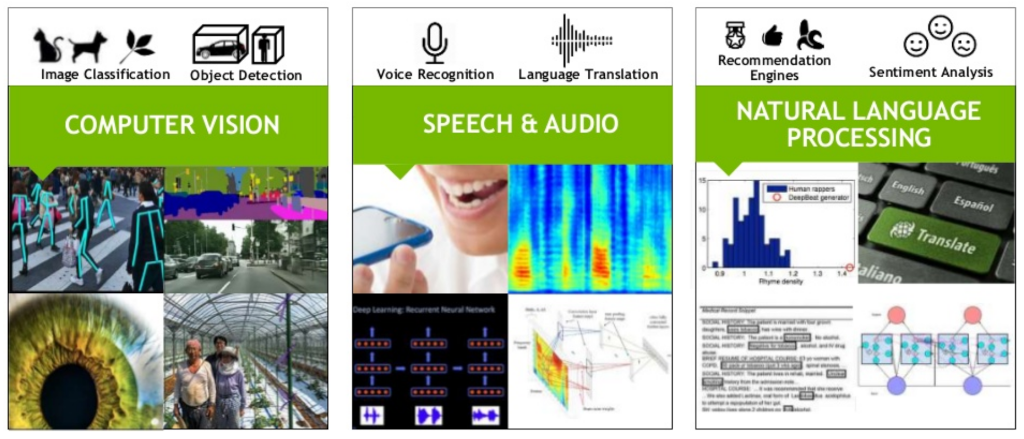
Programming "2.0"
- Programming
- Machine Learning
- Deep Learning
Programming
- Give the computer explicit instructions
- Languages like:
-
- C++
- Javascript
- Python
- ...
- Results ~ Human Ingenuity (1970+)
Traditional Machine Learning
- Make the computer learn from data
-
- Origins in "Statistics"
- Frameworks like:
-
- "R"
- Python + SciKitLearn
- ... Big Data ...
- Results ~ Data size + Features (1990+)
Deep Learning
- Make the computer learn from data
-
- ... where more 'intuition' is required
- Frameworks like:
-
- TensorFlow Keras
- PyTorch
- ...
- Results ~ Data size + Research (2012+)
Simple Dataset
(blue dots = data)
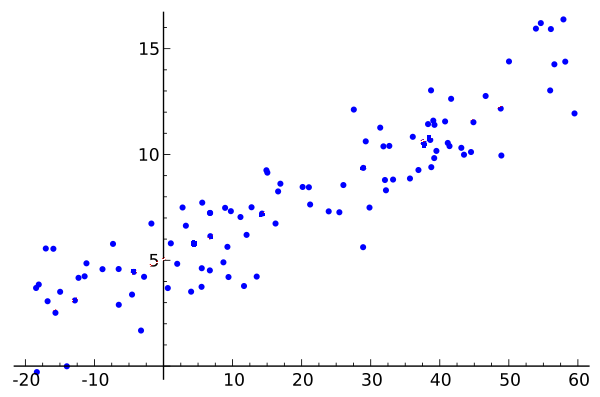
One output ← One input
$y = f(x)$
Traditional Machine Learning
(red line = best fit)
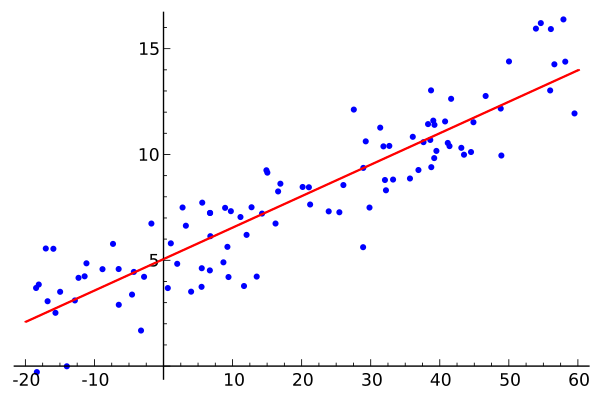
Can solve for 'slope' and 'intercept' exactly
$y = mx + b$
Deep Learning
(red line = better-and-better fit)
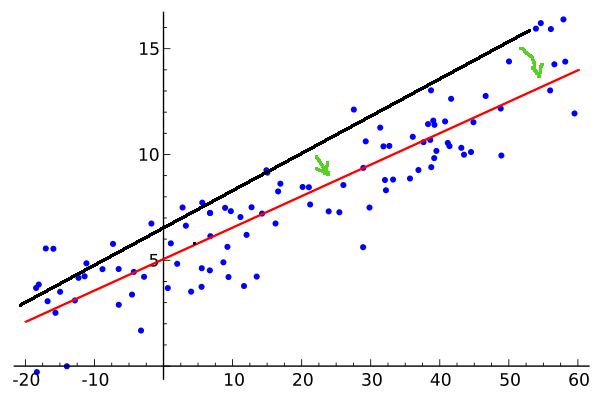
Try to search for parameters $w$ and $b$ iteratively
$y = wx + b$
Why do this iteratively?
- Traditional ML techniques:
-
- Restrict relationships $x$ → $y$
- Limit 'Goodness of fit' measures
- Want 'features' from experts
- Deep Learning:
-
- Can solve more intricate problems
- Allow more flexible 'fit' measures
- Given enough data, can create own features
Deep Learning Key Ingredients
- Lots of Data
- Frameworks / construction kits that :
-
- Have useful components
- Can differentiate (maths)
-
- Allows iterations to move parameters ...
- ... in helpful directions
- Lots of Compute:
-
- GPUs (Graphical Processing Units)
- TPUs (Tensor Processing Units)
Deep Learning Key Steps
- Get some compute: Google Colab is our friend
- Get some data: Use simple example dataset today
- Build a model:
-
- Guess at what kind of 'layers' will be useful
- ... a bit of an art
- Randomly initialise the model parameters (!)
- Work out the 'amount of error':
-
- ... and figure out which direction improves it
- Optimise the model:
-
- ... by taking small parameter steps
Model Building
- Today = the Basics:
-
InputLayer = image 'flattened out'LinearLayer : $y = wx + b$, akaDenseLayer : $\textbf{y} = \textbf{W}.\textbf{x} + \textbf{b}$OutputLayer = the end output
- But this is just a linear regression!
Model Building pt2
- Multiple Layers :
-
- Can pile up
Denselayers - But interleave 'non-linear' activation functions
-
- ... allows more complex interactions
- Can pile up
- Framework can 'trace' through the model
-
- (so that it knows error-fixing-direction)
- Optimiser can then ...
-
- ... nudge all the parameters to improve model
Model Layers
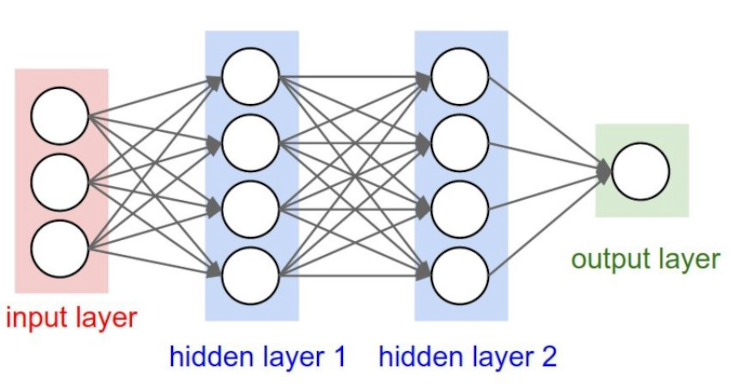
Non-Linear activation
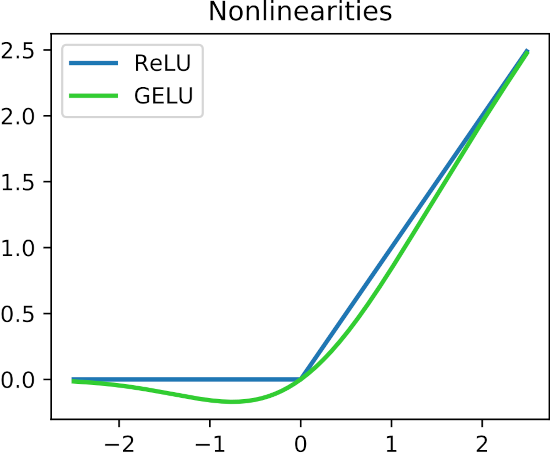
TensorFlow Playground
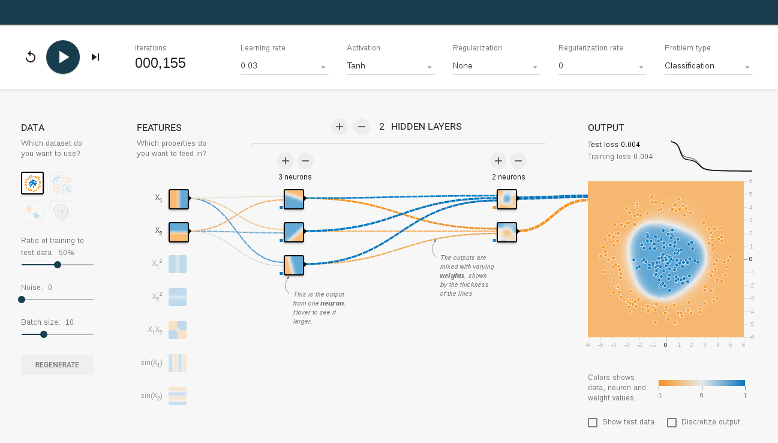
http://playground.tensorflow.org/
What's Going On?
- Task : Colour the regions to capture the points
- Dataset : Choose 1 of the 4 given
- Input : Sample points
- Output : Colour of each point
- First Layer : Pre-selected features
- Training : Play button
- Loss Measure : Graph
- Epoch : 1 run through all training data
Model Building pt3
- ( just ahead of the code-along )
- If we need Multi-way classification:
-
- Output a score for each class - ideally, probabilities
- Use a
SoftMaxLayer
- Target for classification:
-
- Instead of "Cat", "Dog", "Bird" (or 0, 1, 2)
- Use : [1,0,0], [0,1,0], [0,0,1]
-
- (called a One Hot Encoding)
- Error measure for classification:
categorical_cross_entropy
Summary so far
- We're about to do hands-on Deep Learning!
- In the code-along you will:
-
- Use Colab with its free GPU
- Grab a dataset
- Build a model - using
Dense,ReLUandSoftMax - Measure the model error
- Iteratively fit the model to the data
- ... by taking small optimiser steps
- End result : Achieving first steps in Deep Learning
- Code-Along! -
Further Study
- Field is growing very rapidly
- Lots of different things can be done
- Easy to find novel methods / applications
Deep Learning Foundations
- 3 week-days + online content
- Play with real models & Pick-a-Project
- Funding, Certificates, etc
- Dates : 26, 27 and 30 July
https://www.sginnovate.com/
talent-development
Foundations of DL
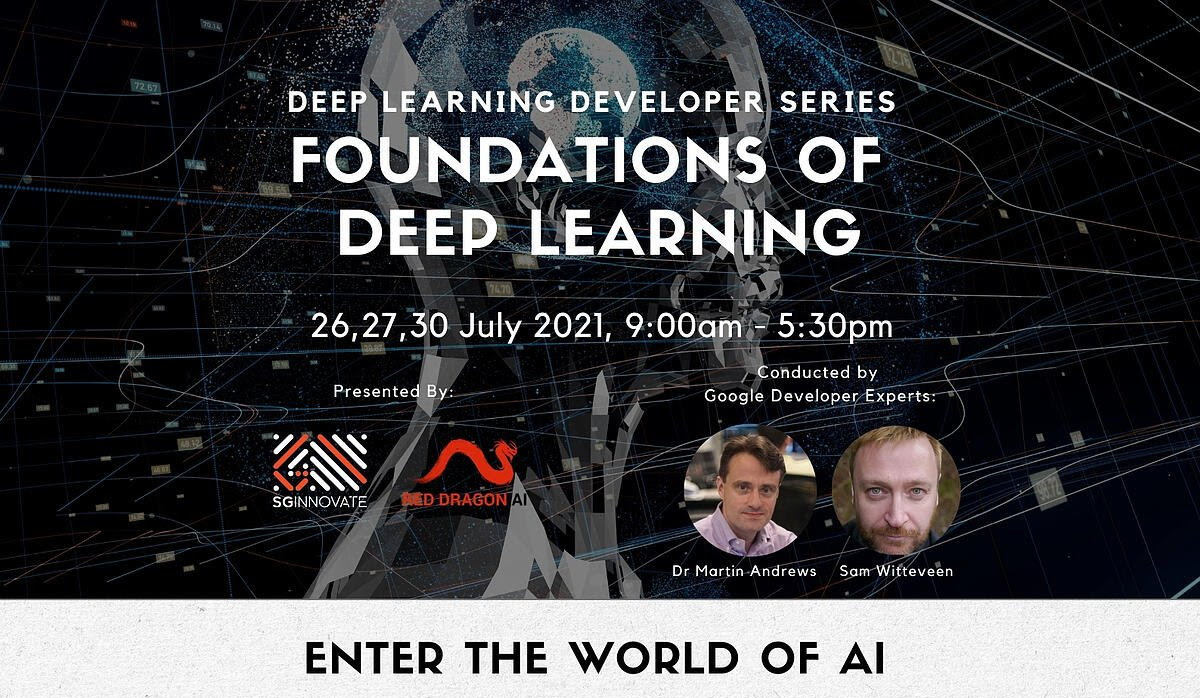
Foundations of DL
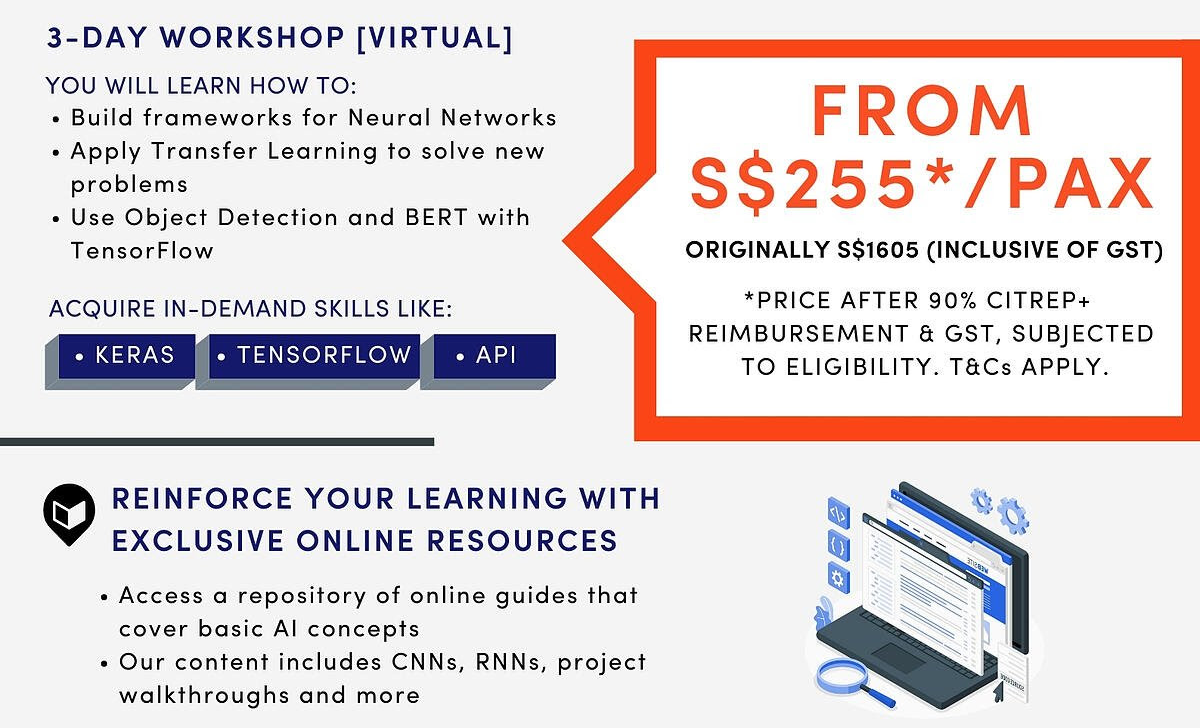
Vision (Advanced)
Advanced Computer Vision with Deep Learning
- Advanced classification
- Generative Models (Style transfer)
- Deconvolution (Super-resolution)
- U-Nets (Segmentation)
- Object Detection
- 2 day course
Sequences (Advanced)
Advanced NLP and Temporal Sequence Processing
- Named Entity Recognition
- Q&A systems
- seq2seq
- Neural Machine Translation
- Attention mechanisms
- Attention-is-all-You-Need
- 3 day course : Dates TBA @ SGInnovate
Unsupervised methods
- Clustering & Anomaly detection
- Latent spaces & Contrastive Learning
- Autoencoders, VAEs, etc
- GANs (WGAN, Condition-GAN, CycleGAN)
- Reinforcement Learning
- 2 day course
Real World Apps
Building Real World A.I. Applications
- DIY : node-server + redis-queue + python-ml
- TensorFlow Serving
- TensorFlow Lite + CoreML
- Model distillation
- ++
- 3 day course : Dates TBA @ SGInnovate
Deep Learning
MeetUp Group
- Next Regular Meeting ~ 1 month
-
- Hosted by Google
- Typical Contents :
-
- Talk for people starting out
- Something from the bleeding-edge
- Lightning Talks
- MeetUp.com / TensorFlow-and-Deep-Learning-Singapore
- QUESTIONS -
Martin @ RedDragon . ai
Sam @ RedDragon . ai
My blog : http://mdda.net/
GitHub : mdda